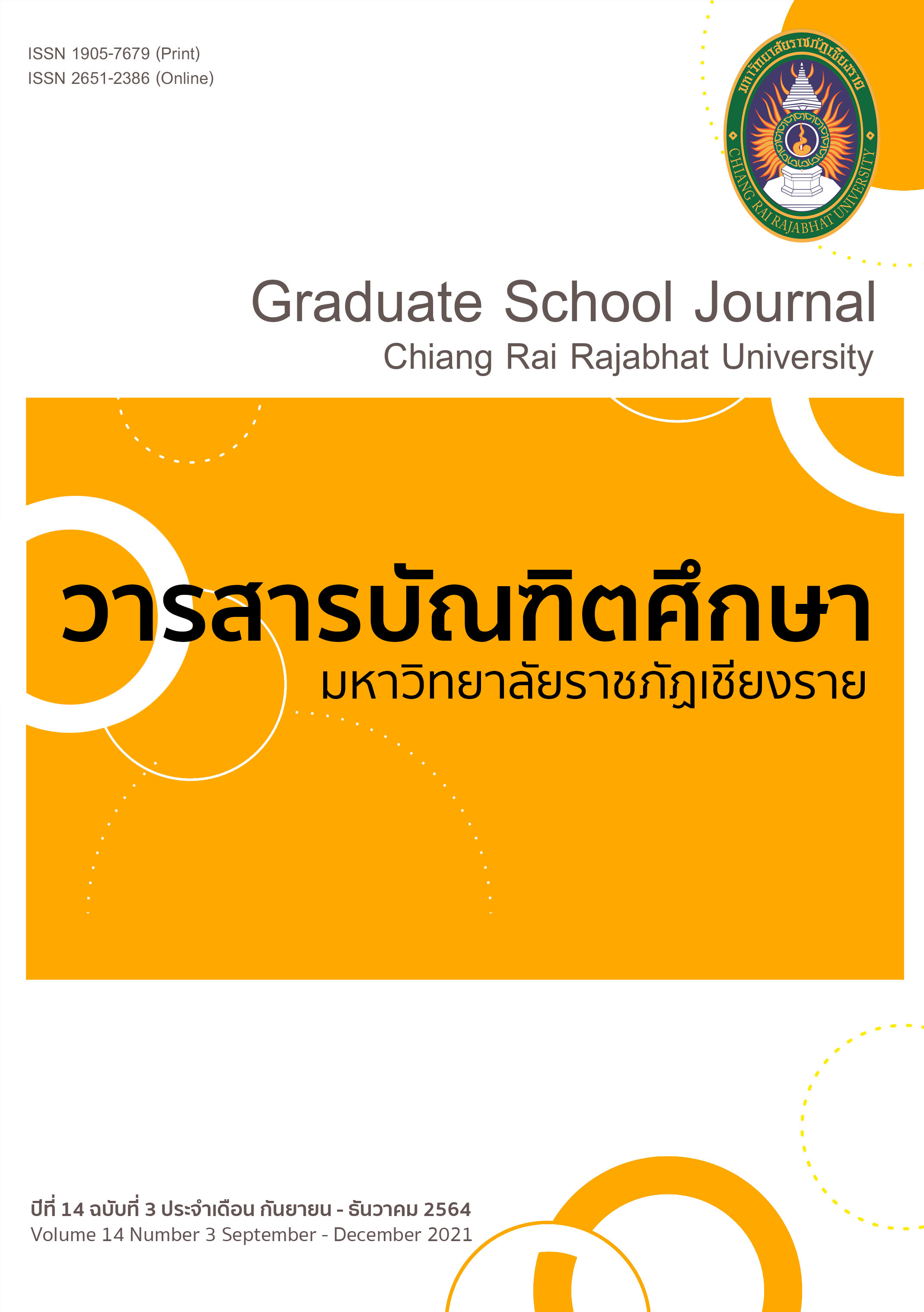การวิเคราะห์การสลับภาษาของนักศึกษาสาขาวิชาภาษาอังกฤษศึกษาและ อาจารย์ที่ใช้ภาษาอังกฤษเป็นสื่อในการสอนผ่านห้องเรียนออนไลน์
Main Article Content
บทคัดย่อ
การศึกษาวิจัยเรื่อง"การวิเคราะห์การสลับภาษาของนักศึกษาสาขาวิชาภาษาอังกฤษศึกษาและอาจารย์ชาวไทยที่ใช้ภาษาอังกฤษเป็นสื่อในการสอนผ่านห้องเรียนออนไลน์มีวัตถุประสงค์เพื่อศึกษาและจำแนกประเภทของการสลับภาษาที่ใช้ภาษาอังกฤษเป็นสื่อในการเรียนการสอนผ่านห้องเรียนออนไลน์และเพื่อวิเคราะห์ประเภทของการสลับภาษาที่ใช้ภาษาอังกฤษของนักศึกษาชั้นปีที่ 3 สาขาวิชาภาษาอังกฤษศึกษา จำนวน 35 คน กับอาจารย์ชาวไทยที่ใช้ภาษาอังกฤษเป็นสื่อในการสอนผ่านห้องเรียนออนไลน์ จำนวน 1 คน ณ คณะมนุษยศาสตร์ มหาวิทยาลัยราชภัฏเชียงราย โดยใช้วิธีการเลือกกลุ่มตัวอย่างแบบเจาะจงกับ เครื่องมือที่ใช้ในการวิจัยครั้งนี้ ได้แก่ ห้องเรียนผ่านโปรแกรมซูมและกูเกิ้ลมีท วิดีโอบันทึกภาพและเสียงในโปรแกรมซูมและกูเกิ้ลมีท แบบสังเกตการสลับภาษา และการสัมภาษณ์เชิงลึกแบบตัวต่อตัวผ่านโปรแกรมออนไลน์ วิเคราะห์ข้อมูลโดยการระบุและจัดประเภท รวมทั้งสรุปผลการศึกษา และนำเสนอผลการศึกษาเชิงพรรณนาโดยใช้สถิติในการวิเคราะห์ข้อมูล ได้แก่ ร้อยละและการแจกแจงความถี่
ผลการวิจัยพบว่า 1) ประเภทของการสลับภาษาจากภาษาอังกฤษเป็นภาษาไทยที่ใช้บ่อยที่สุดในการสอนผ่านห้องเรียนออนไลน์ของอาจารย์ชาวไทย คือ การให้ความชัดเจนร้อยละ 76.14 ในขณะเดียวกัน การเรียกความสนใจมีการสลับภาษาน้อยที่สุดร้อยละ 0.96 นอกจากนี้การสลับภาษาจากภาษาไทยเป็นภาษาอังกฤษของอาจารย์ชาวไทย พบว่า ประเภทของการสลับภาษาจากภาษาไทยไปภาษาอังกฤษที่ใช้บ่อย 2) ผลสัมฤทธิ์ทางการเรียนหลังจากศึกษาด้วยโมบายแอปพลิเคชันของผู้เรียนสูงกว่าก่อนเรียนอย่างมีนัยสำคัญทางสถิติที่ระดับ 0.05 3) ผู้เรียนโมบายแอปพลิเคชันมีความพึงพอใจต่อการใช้แอปพลิเคชันอยู่ในระดับมาก ( = 4.42, S.D. = 0.65)
Article Details
บทความที่ได้รับการตีพิมพ์เป็นลิขสิทธิ์ของวารสารมหาวิทยาลัยราชภัฎเชียงราย
ข้อความที่ปรากฏในบทความแต่ละเรื่องในวารสารวิชาการเล่มนี้เป็นความคิดเห็นส่วนตัวของผู้เขียนแต่ละท่านไม่เกี่ยวข้องกับมหาวิทยาลัยราชภัฎเชียงราย และคณาจารย์ท่านอื่นๆในมหาวิทยาลัยฯ แต่อย่างใด ความรับผิดชอบองค์ประกอบทั้งหมดของบทความแต่ละเรื่องเป็นของผู้เขียนแต่ละท่าน หากมีความผิดพลาดใดๆ ผู้เขียนแต่ละท่านจะรับผิดชอบบทความของตนเองแต่ผู้เดียว
เอกสารอ้างอิง
Auer, P. (1998). Code-switching in Conversation : Language, Interaction and Identity. London: Routledge.
Bokamba, E. G. (1989). Are there syntactic constraints on code‐mixing?. World Englishes, 8 (3), 277-292.
Brown, H. D. (2000). Principles of language learning and teaching. (4th ed.). New York: Longman. 14
Cook, V. (2000). Second language learning and language teaching. Beijing: Foreign Language Teaching and Research Press and Edward Arnold.
Ellis, R. (1994). The study of second language acquisition. Oxford, England: Oxford University Press.
Faltis, C. (1989). Code-switching and bilingual schooling : An examination of Jacobson's new concurrent approach. Journal of Multilingual and Multicultura Development, 10(2), 117-127.
Hymes, D. (1976). Foundations In sociolinguistics : An ethnographic approach. London: Longman.
Isa, S. (2013). Using native language in ESL classroom. II-ELTS International Journal of English Language & Translation Studies, 1(2), 243-248.
Koziol, J. M. (2000). Code-switching between Spanish and English in contemporary American society. Retrieved December 7, 2017, from http://www.smcm.edu/aldiv/i1c/pdfdocs/koziol.pdf
Lightbown, P. M. (2001). PM. L2 instruction : Time to teach. TESOL Quarterly, 35, 598-599.
Maschler, Y. (1998). The tradition to a mixed code. In P. Aner (Ed.), Codeswitching in Conversation. (pp.125-149). London: Routledge.
McClure, E. (1982). Code switching, bilingualism, and bilitercy : A case study Ana Huerta –Macas. Retrieved December 8, 2017, from http://citesee.ist.psu.edu/451693.html
Medgyes, P. (2001). When the teacher is a non-native speaker. In M. Celce-Murcia (Ed.), Teaching English as a second or foreign language. Boston, MA: Heinle & Heinle.
Ministry of Education. (2008). Basic Language Curriculum B.E. 2551 (A.D. 2008). Bangkok: Ministry of Education
Muysken, P. (2000). Bilingual speech : A typology of code-switching. Oxford: Cambridge University Press.
Reyes, B. A. (1995). Considerations in the assessment and treatment of neurogenic disorders in bilingual adults. Bilingual Speech-Language Pathology, 1, 153-182.
Reyes, I. (2001). Code-Switching and borrowing : Discourse strategies in developing bilingual children’s interactions. Actas : Proceedings II Simposio Internacional Bilinguismo, 12, 319 – 331.
Reyes, I. (2004). Functions of code switching in schoolchildren’s conversations. Bilingual Research Journal, 28(1), 77-98.
Sert, O. (2005). The functions of code-switching in ELT classrooms. The Internet TESL Journal, 9(8), 1.
Sriudomkij, P., and Sopirak, S. (2013). Factors Influencing the development in English pronunciation skills training in primary students of schools in the Primary Education Services Area Office in Bangkok. Procedia-Social and Behavioral Sciences, 103, 396-399.
Stern, H. (1992). Issues and options in language teaching. Oxford: Oxford University Press.
Zhang, S. (2009). The role input, interaction, and output in the development of oral fluency. English Language Teaching, 2(4), 91.


